Dry Eye Disease: Symptoms, Diagnosis, and Impact on Patient Wellbeing
VerifiedAdded on 2023/06/10
|6
|2588
|298
Report
AI Summary
This report synthesizes information from various abstracts and research papers concerning dry eye disease (DED). It explores the impact of DED and its treatments on patients' quality of life, including physical, psychological, and social dimensions. The report analyzes patient perspectives, symptom characteristics, and the relationship between DED and driving performance, highlighting the inconveniences and potential risks associated with the condition. It examines the diagnostic methods, including both subjective and objective techniques, and the role of tear osmolarity. The report also discusses the correlation between dry eyes and migraines, emphasizing the need for effective symptom assessment and treatment strategies. This report aims to provide a comprehensive overview of DED, its multifaceted implications, and the importance of patient-centered care. The provided abstracts cover various aspects of dry eye disease, ranging from the impact of the disease on the quality of life to the correlation between dry eyes and migraines. These abstracts also emphasize the importance of valid symptom assessment and the different methods used to monitor dry eye syndrome treatment.
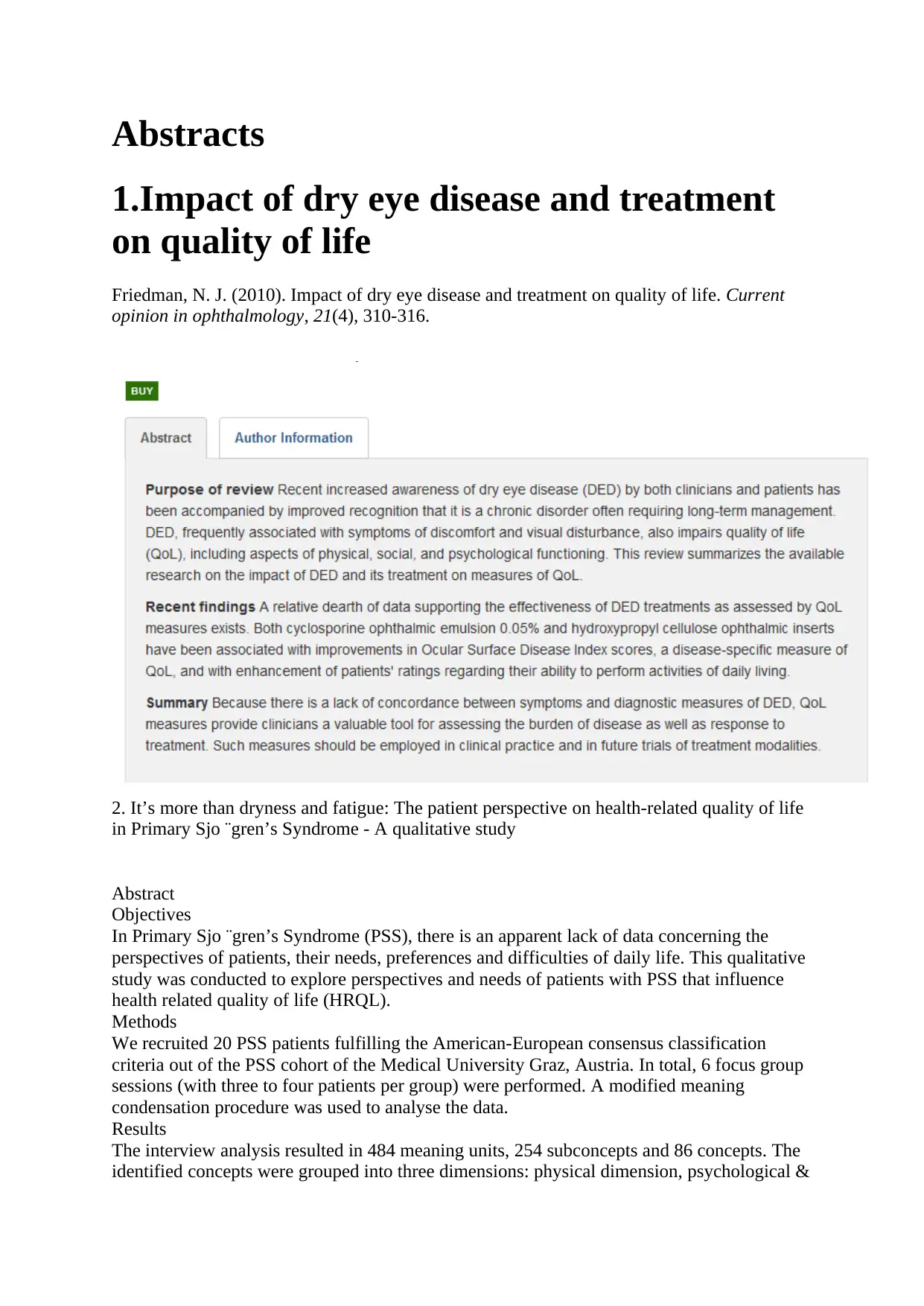
Abstracts
1.Impact of dry eye disease and treatment
on quality of life
Friedman, N. J. (2010). Impact of dry eye disease and treatment on quality of life. Current
opinion in ophthalmology, 21(4), 310-316.
2. It’s more than dryness and fatigue: The patient perspective on health-related quality of life
in Primary Sjo ¨gren’s Syndrome - A qualitative study
Abstract
Objectives
In Primary Sjo ¨gren’s Syndrome (PSS), there is an apparent lack of data concerning the
perspectives of patients, their needs, preferences and difficulties of daily life. This qualitative
study was conducted to explore perspectives and needs of patients with PSS that influence
health related quality of life (HRQL).
Methods
We recruited 20 PSS patients fulfilling the American-European consensus classification
criteria out of the PSS cohort of the Medical University Graz, Austria. In total, 6 focus group
sessions (with three to four patients per group) were performed. A modified meaning
condensation procedure was used to analyse the data.
Results
The interview analysis resulted in 484 meaning units, 254 subconcepts and 86 concepts. The
identified concepts were grouped into three dimensions: physical dimension, psychological &
1.Impact of dry eye disease and treatment
on quality of life
Friedman, N. J. (2010). Impact of dry eye disease and treatment on quality of life. Current
opinion in ophthalmology, 21(4), 310-316.
2. It’s more than dryness and fatigue: The patient perspective on health-related quality of life
in Primary Sjo ¨gren’s Syndrome - A qualitative study
Abstract
Objectives
In Primary Sjo ¨gren’s Syndrome (PSS), there is an apparent lack of data concerning the
perspectives of patients, their needs, preferences and difficulties of daily life. This qualitative
study was conducted to explore perspectives and needs of patients with PSS that influence
health related quality of life (HRQL).
Methods
We recruited 20 PSS patients fulfilling the American-European consensus classification
criteria out of the PSS cohort of the Medical University Graz, Austria. In total, 6 focus group
sessions (with three to four patients per group) were performed. A modified meaning
condensation procedure was used to analyse the data.
Results
The interview analysis resulted in 484 meaning units, 254 subconcepts and 86 concepts. The
identified concepts were grouped into three dimensions: physical dimension, psychological &
Paraphrase This Document
Need a fresh take? Get an instant paraphrase of this document with our AI Paraphraser
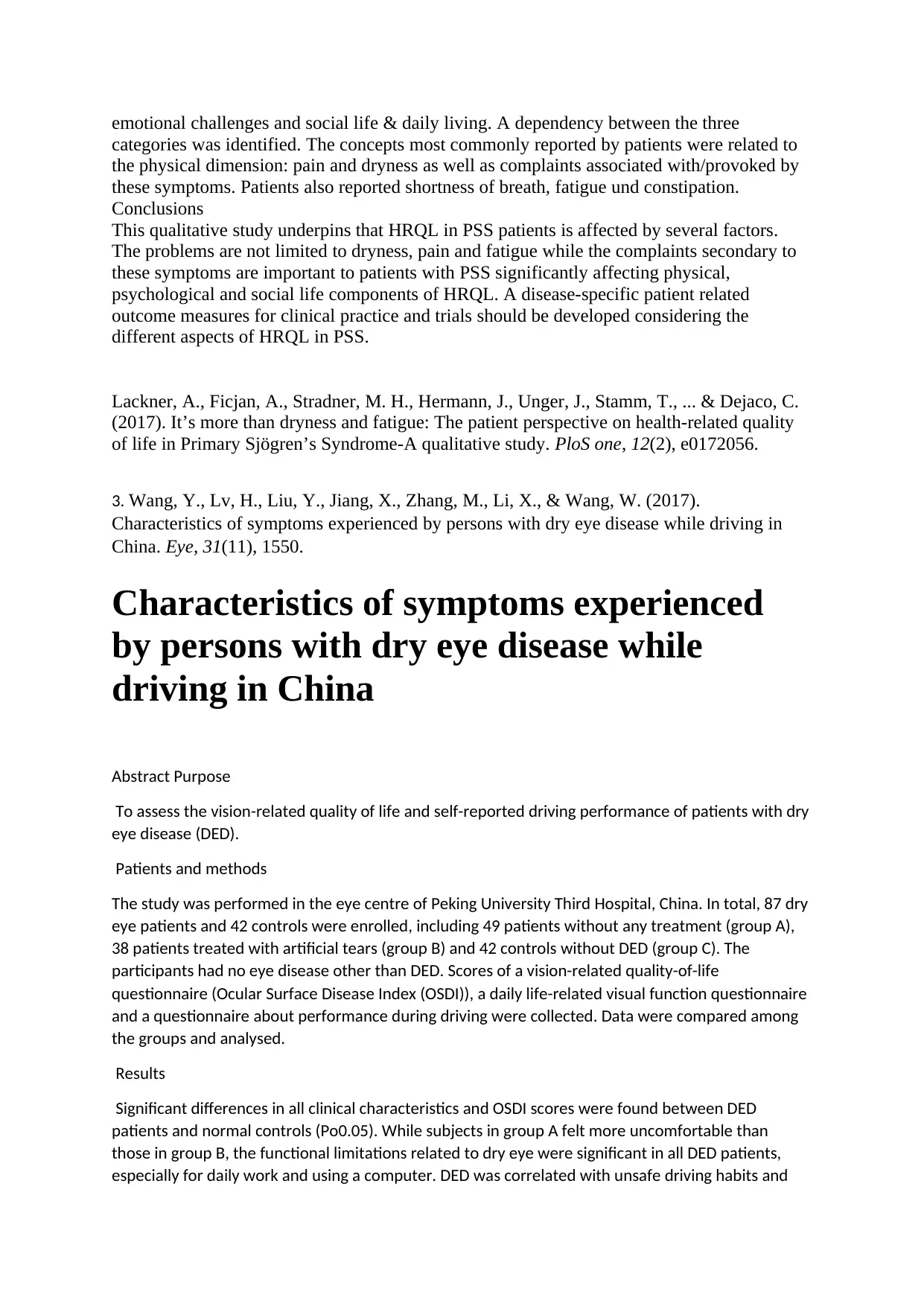
emotional challenges and social life & daily living. A dependency between the three
categories was identified. The concepts most commonly reported by patients were related to
the physical dimension: pain and dryness as well as complaints associated with/provoked by
these symptoms. Patients also reported shortness of breath, fatigue und constipation.
Conclusions
This qualitative study underpins that HRQL in PSS patients is affected by several factors.
The problems are not limited to dryness, pain and fatigue while the complaints secondary to
these symptoms are important to patients with PSS significantly affecting physical,
psychological and social life components of HRQL. A disease-specific patient related
outcome measures for clinical practice and trials should be developed considering the
different aspects of HRQL in PSS.
Lackner, A., Ficjan, A., Stradner, M. H., Hermann, J., Unger, J., Stamm, T., ... & Dejaco, C.
(2017). It’s more than dryness and fatigue: The patient perspective on health-related quality
of life in Primary Sjögren’s Syndrome-A qualitative study. PloS one, 12(2), e0172056.
3. Wang, Y., Lv, H., Liu, Y., Jiang, X., Zhang, M., Li, X., & Wang, W. (2017).
Characteristics of symptoms experienced by persons with dry eye disease while driving in
China. Eye, 31(11), 1550.
Characteristics of symptoms experienced
by persons with dry eye disease while
driving in China
Abstract Purpose
To assess the vision-related quality of life and self-reported driving performance of patients with dry
eye disease (DED).
Patients and methods
The study was performed in the eye centre of Peking University Third Hospital, China. In total, 87 dry
eye patients and 42 controls were enrolled, including 49 patients without any treatment (group A),
38 patients treated with artificial tears (group B) and 42 controls without DED (group C). The
participants had no eye disease other than DED. Scores of a vision-related quality-of-life
questionnaire (Ocular Surface Disease Index (OSDI)), a daily life-related visual function questionnaire
and a questionnaire about performance during driving were collected. Data were compared among
the groups and analysed.
Results
Significant differences in all clinical characteristics and OSDI scores were found between DED
patients and normal controls (Po0.05). While subjects in group A felt more uncomfortable than
those in group B, the functional limitations related to dry eye were significant in all DED patients,
especially for daily work and using a computer. DED was correlated with unsafe driving habits and
categories was identified. The concepts most commonly reported by patients were related to
the physical dimension: pain and dryness as well as complaints associated with/provoked by
these symptoms. Patients also reported shortness of breath, fatigue und constipation.
Conclusions
This qualitative study underpins that HRQL in PSS patients is affected by several factors.
The problems are not limited to dryness, pain and fatigue while the complaints secondary to
these symptoms are important to patients with PSS significantly affecting physical,
psychological and social life components of HRQL. A disease-specific patient related
outcome measures for clinical practice and trials should be developed considering the
different aspects of HRQL in PSS.
Lackner, A., Ficjan, A., Stradner, M. H., Hermann, J., Unger, J., Stamm, T., ... & Dejaco, C.
(2017). It’s more than dryness and fatigue: The patient perspective on health-related quality
of life in Primary Sjögren’s Syndrome-A qualitative study. PloS one, 12(2), e0172056.
3. Wang, Y., Lv, H., Liu, Y., Jiang, X., Zhang, M., Li, X., & Wang, W. (2017).
Characteristics of symptoms experienced by persons with dry eye disease while driving in
China. Eye, 31(11), 1550.
Characteristics of symptoms experienced
by persons with dry eye disease while
driving in China
Abstract Purpose
To assess the vision-related quality of life and self-reported driving performance of patients with dry
eye disease (DED).
Patients and methods
The study was performed in the eye centre of Peking University Third Hospital, China. In total, 87 dry
eye patients and 42 controls were enrolled, including 49 patients without any treatment (group A),
38 patients treated with artificial tears (group B) and 42 controls without DED (group C). The
participants had no eye disease other than DED. Scores of a vision-related quality-of-life
questionnaire (Ocular Surface Disease Index (OSDI)), a daily life-related visual function questionnaire
and a questionnaire about performance during driving were collected. Data were compared among
the groups and analysed.
Results
Significant differences in all clinical characteristics and OSDI scores were found between DED
patients and normal controls (Po0.05). While subjects in group A felt more uncomfortable than
those in group B, the functional limitations related to dry eye were significant in all DED patients,
especially for daily work and using a computer. DED was correlated with unsafe driving habits and
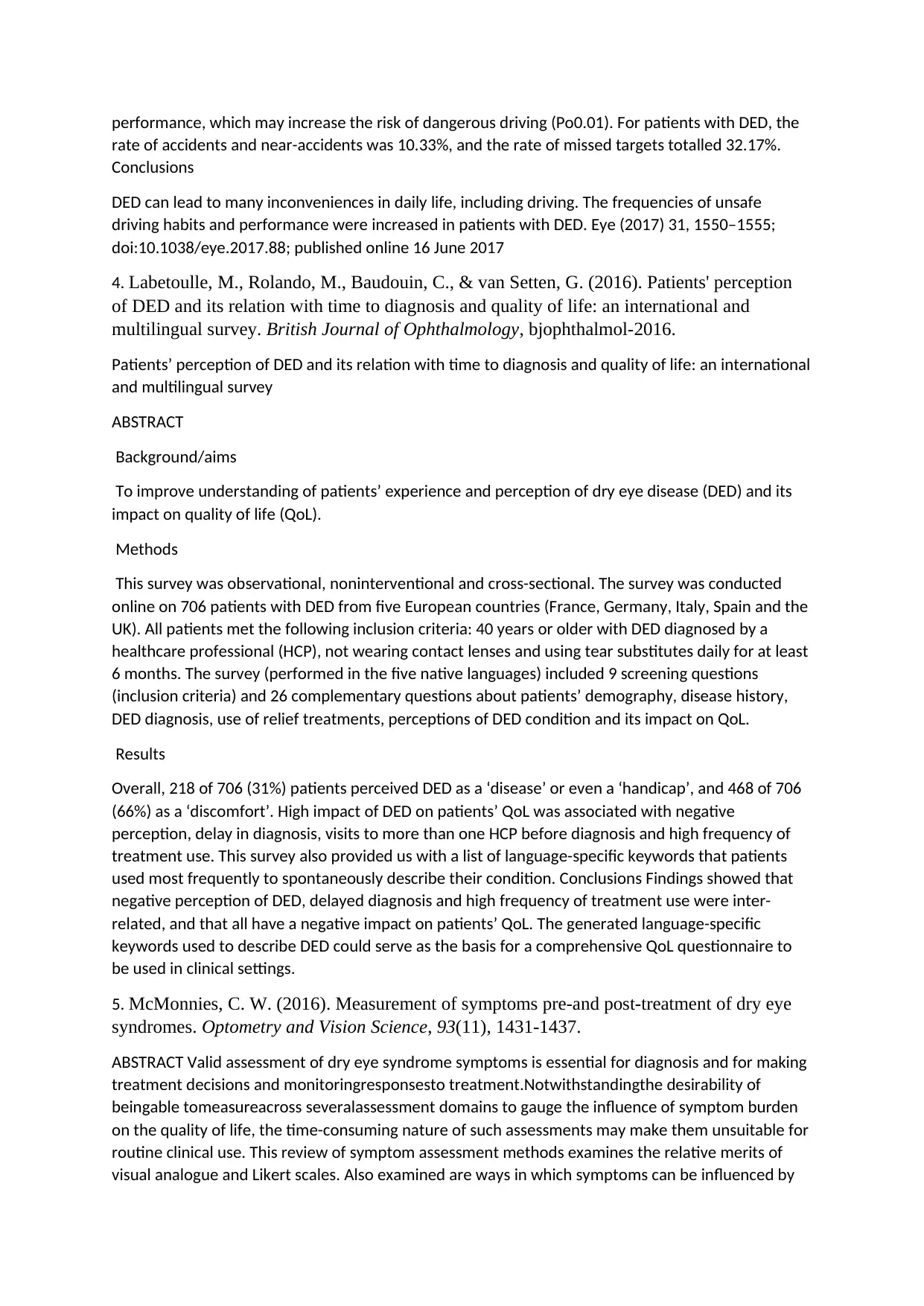
performance, which may increase the risk of dangerous driving (Po0.01). For patients with DED, the
rate of accidents and near-accidents was 10.33%, and the rate of missed targets totalled 32.17%.
Conclusions
DED can lead to many inconveniences in daily life, including driving. The frequencies of unsafe
driving habits and performance were increased in patients with DED. Eye (2017) 31, 1550–1555;
doi:10.1038/eye.2017.88; published online 16 June 2017
4. Labetoulle, M., Rolando, M., Baudouin, C., & van Setten, G. (2016). Patients' perception
of DED and its relation with time to diagnosis and quality of life: an international and
multilingual survey. British Journal of Ophthalmology, bjophthalmol-2016.
Patients’ perception of DED and its relation with time to diagnosis and quality of life: an international
and multilingual survey
ABSTRACT
Background/aims
To improve understanding of patients’ experience and perception of dry eye disease (DED) and its
impact on quality of life (QoL).
Methods
This survey was observational, noninterventional and cross-sectional. The survey was conducted
online on 706 patients with DED from five European countries (France, Germany, Italy, Spain and the
UK). All patients met the following inclusion criteria: 40 years or older with DED diagnosed by a
healthcare professional (HCP), not wearing contact lenses and using tear substitutes daily for at least
6 months. The survey (performed in the five native languages) included 9 screening questions
(inclusion criteria) and 26 complementary questions about patients’ demography, disease history,
DED diagnosis, use of relief treatments, perceptions of DED condition and its impact on QoL.
Results
Overall, 218 of 706 (31%) patients perceived DED as a ‘disease’ or even a ‘handicap’, and 468 of 706
(66%) as a ‘discomfort’. High impact of DED on patients’ QoL was associated with negative
perception, delay in diagnosis, visits to more than one HCP before diagnosis and high frequency of
treatment use. This survey also provided us with a list of language-specific keywords that patients
used most frequently to spontaneously describe their condition. Conclusions Findings showed that
negative perception of DED, delayed diagnosis and high frequency of treatment use were inter-
related, and that all have a negative impact on patients’ QoL. The generated language-specific
keywords used to describe DED could serve as the basis for a comprehensive QoL questionnaire to
be used in clinical settings.
5. McMonnies, C. W. (2016). Measurement of symptoms pre-and post-treatment of dry eye
syndromes. Optometry and Vision Science, 93(11), 1431-1437.
ABSTRACT Valid assessment of dry eye syndrome symptoms is essential for diagnosis and for making
treatment decisions and monitoringresponsesto treatment.Notwithstandingthe desirability of
beingable tomeasureacross severalassessment domains to gauge the influence of symptom burden
on the quality of life, the time-consuming nature of such assessments may make them unsuitable for
routine clinical use. This review of symptom assessment methods examines the relative merits of
visual analogue and Likert scales. Also examined are ways in which symptoms can be influenced by
rate of accidents and near-accidents was 10.33%, and the rate of missed targets totalled 32.17%.
Conclusions
DED can lead to many inconveniences in daily life, including driving. The frequencies of unsafe
driving habits and performance were increased in patients with DED. Eye (2017) 31, 1550–1555;
doi:10.1038/eye.2017.88; published online 16 June 2017
4. Labetoulle, M., Rolando, M., Baudouin, C., & van Setten, G. (2016). Patients' perception
of DED and its relation with time to diagnosis and quality of life: an international and
multilingual survey. British Journal of Ophthalmology, bjophthalmol-2016.
Patients’ perception of DED and its relation with time to diagnosis and quality of life: an international
and multilingual survey
ABSTRACT
Background/aims
To improve understanding of patients’ experience and perception of dry eye disease (DED) and its
impact on quality of life (QoL).
Methods
This survey was observational, noninterventional and cross-sectional. The survey was conducted
online on 706 patients with DED from five European countries (France, Germany, Italy, Spain and the
UK). All patients met the following inclusion criteria: 40 years or older with DED diagnosed by a
healthcare professional (HCP), not wearing contact lenses and using tear substitutes daily for at least
6 months. The survey (performed in the five native languages) included 9 screening questions
(inclusion criteria) and 26 complementary questions about patients’ demography, disease history,
DED diagnosis, use of relief treatments, perceptions of DED condition and its impact on QoL.
Results
Overall, 218 of 706 (31%) patients perceived DED as a ‘disease’ or even a ‘handicap’, and 468 of 706
(66%) as a ‘discomfort’. High impact of DED on patients’ QoL was associated with negative
perception, delay in diagnosis, visits to more than one HCP before diagnosis and high frequency of
treatment use. This survey also provided us with a list of language-specific keywords that patients
used most frequently to spontaneously describe their condition. Conclusions Findings showed that
negative perception of DED, delayed diagnosis and high frequency of treatment use were inter-
related, and that all have a negative impact on patients’ QoL. The generated language-specific
keywords used to describe DED could serve as the basis for a comprehensive QoL questionnaire to
be used in clinical settings.
5. McMonnies, C. W. (2016). Measurement of symptoms pre-and post-treatment of dry eye
syndromes. Optometry and Vision Science, 93(11), 1431-1437.
ABSTRACT Valid assessment of dry eye syndrome symptoms is essential for diagnosis and for making
treatment decisions and monitoringresponsesto treatment.Notwithstandingthe desirability of
beingable tomeasureacross severalassessment domains to gauge the influence of symptom burden
on the quality of life, the time-consuming nature of such assessments may make them unsuitable for
routine clinical use. This review of symptom assessment methods examines the relative merits of
visual analogue and Likert scales. Also examined are ways in which symptoms can be influenced by
⊘ This is a preview!⊘
Do you want full access?
Subscribe today to unlock all pages.

Trusted by 1+ million students worldwide
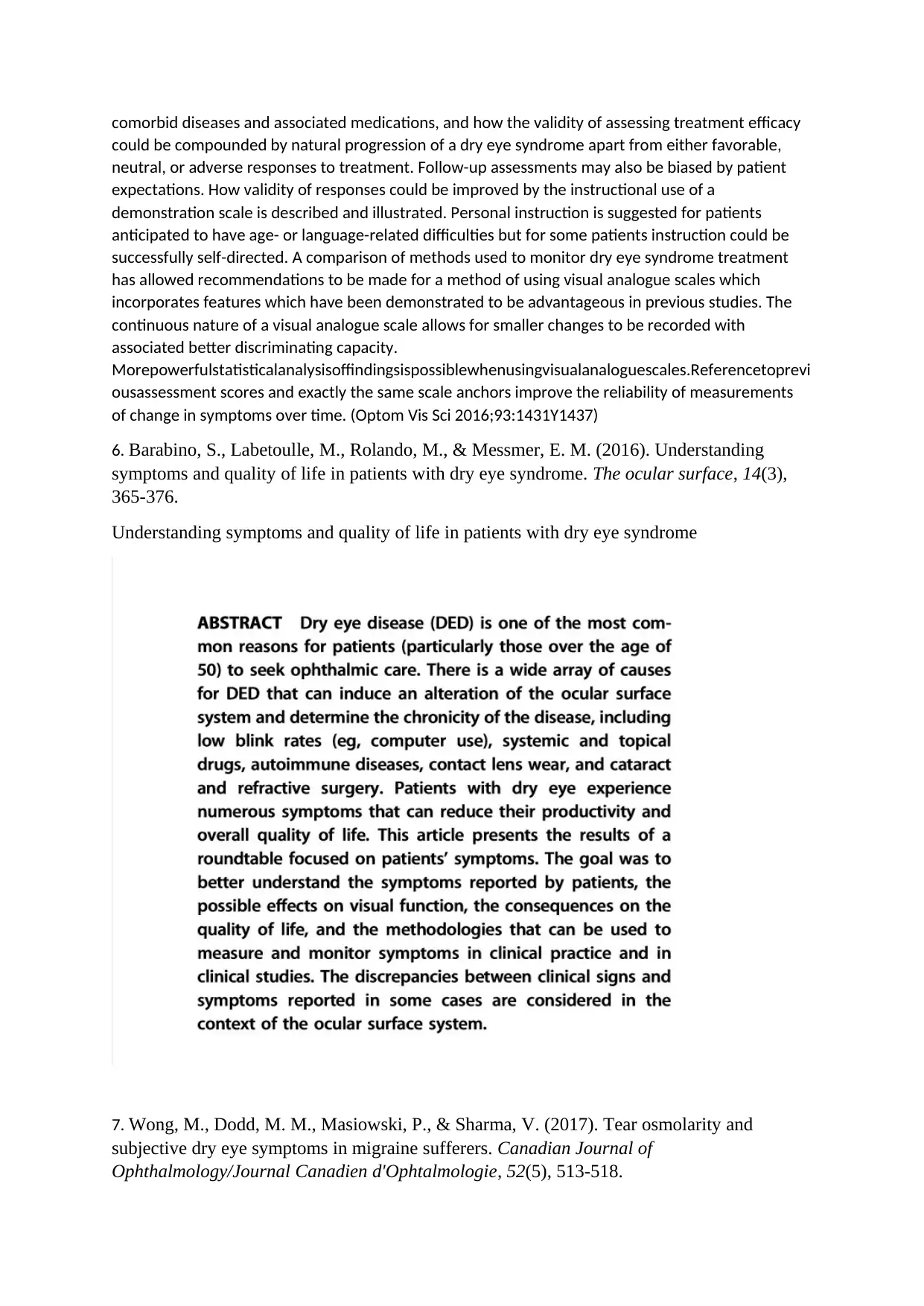
comorbid diseases and associated medications, and how the validity of assessing treatment efficacy
could be compounded by natural progression of a dry eye syndrome apart from either favorable,
neutral, or adverse responses to treatment. Follow-up assessments may also be biased by patient
expectations. How validity of responses could be improved by the instructional use of a
demonstration scale is described and illustrated. Personal instruction is suggested for patients
anticipated to have age- or language-related difficulties but for some patients instruction could be
successfully self-directed. A comparison of methods used to monitor dry eye syndrome treatment
has allowed recommendations to be made for a method of using visual analogue scales which
incorporates features which have been demonstrated to be advantageous in previous studies. The
continuous nature of a visual analogue scale allows for smaller changes to be recorded with
associated better discriminating capacity.
Morepowerfulstatisticalanalysisoffindingsispossiblewhenusingvisualanaloguescales.Referencetoprevi
ousassessment scores and exactly the same scale anchors improve the reliability of measurements
of change in symptoms over time. (Optom Vis Sci 2016;93:1431Y1437)
6. Barabino, S., Labetoulle, M., Rolando, M., & Messmer, E. M. (2016). Understanding
symptoms and quality of life in patients with dry eye syndrome. The ocular surface, 14(3),
365-376.
Understanding symptoms and quality of life in patients with dry eye syndrome
7. Wong, M., Dodd, M. M., Masiowski, P., & Sharma, V. (2017). Tear osmolarity and
subjective dry eye symptoms in migraine sufferers. Canadian Journal of
Ophthalmology/Journal Canadien d'Ophtalmologie, 52(5), 513-518.
could be compounded by natural progression of a dry eye syndrome apart from either favorable,
neutral, or adverse responses to treatment. Follow-up assessments may also be biased by patient
expectations. How validity of responses could be improved by the instructional use of a
demonstration scale is described and illustrated. Personal instruction is suggested for patients
anticipated to have age- or language-related difficulties but for some patients instruction could be
successfully self-directed. A comparison of methods used to monitor dry eye syndrome treatment
has allowed recommendations to be made for a method of using visual analogue scales which
incorporates features which have been demonstrated to be advantageous in previous studies. The
continuous nature of a visual analogue scale allows for smaller changes to be recorded with
associated better discriminating capacity.
Morepowerfulstatisticalanalysisoffindingsispossiblewhenusingvisualanaloguescales.Referencetoprevi
ousassessment scores and exactly the same scale anchors improve the reliability of measurements
of change in symptoms over time. (Optom Vis Sci 2016;93:1431Y1437)
6. Barabino, S., Labetoulle, M., Rolando, M., & Messmer, E. M. (2016). Understanding
symptoms and quality of life in patients with dry eye syndrome. The ocular surface, 14(3),
365-376.
Understanding symptoms and quality of life in patients with dry eye syndrome
7. Wong, M., Dodd, M. M., Masiowski, P., & Sharma, V. (2017). Tear osmolarity and
subjective dry eye symptoms in migraine sufferers. Canadian Journal of
Ophthalmology/Journal Canadien d'Ophtalmologie, 52(5), 513-518.
Paraphrase This Document
Need a fresh take? Get an instant paraphrase of this document with our AI Paraphraser
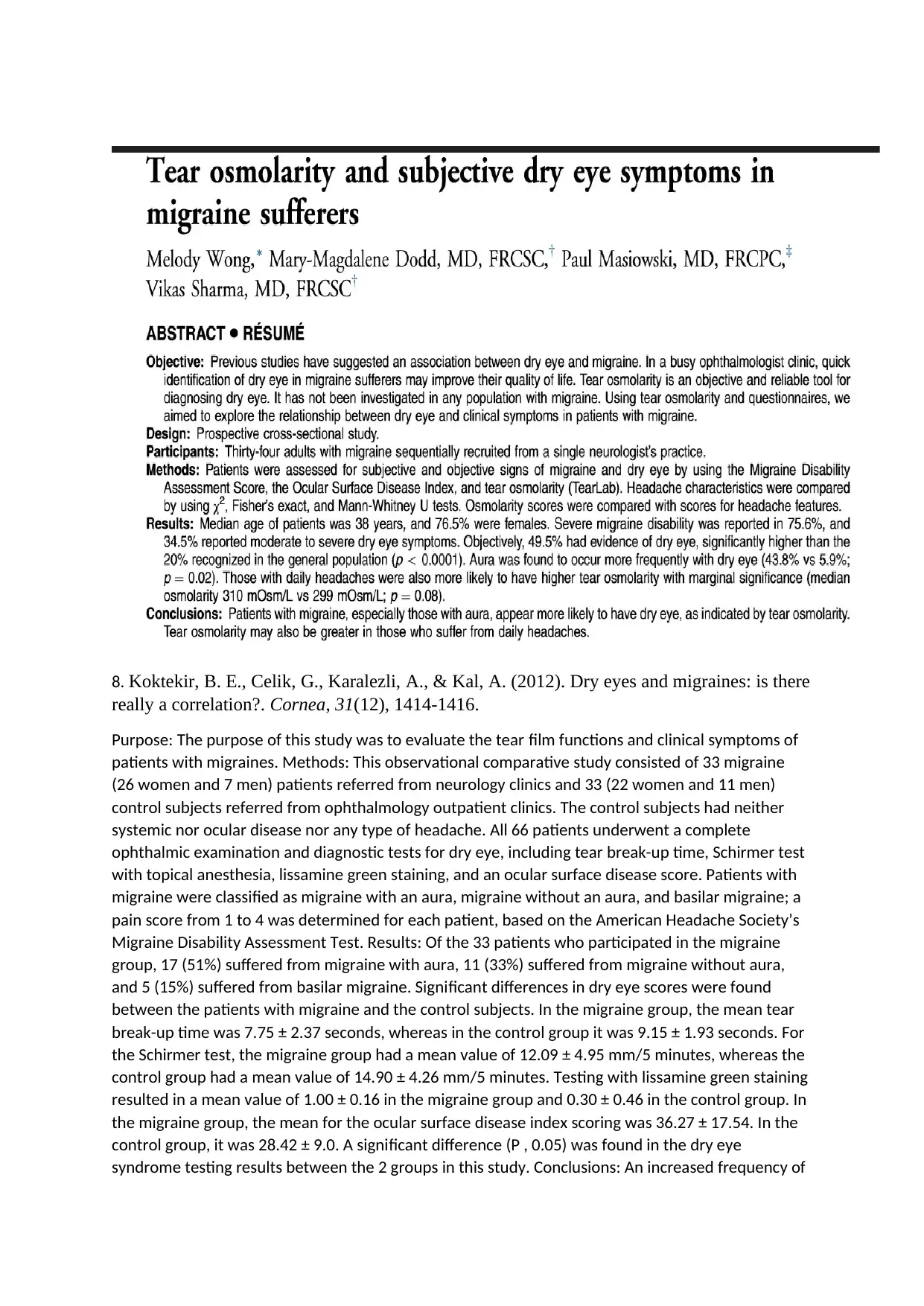
8. Koktekir, B. E., Celik, G., Karalezli, A., & Kal, A. (2012). Dry eyes and migraines: is there
really a correlation?. Cornea, 31(12), 1414-1416.
Purpose: The purpose of this study was to evaluate the tear film functions and clinical symptoms of
patients with migraines. Methods: This observational comparative study consisted of 33 migraine
(26 women and 7 men) patients referred from neurology clinics and 33 (22 women and 11 men)
control subjects referred from ophthalmology outpatient clinics. The control subjects had neither
systemic nor ocular disease nor any type of headache. All 66 patients underwent a complete
ophthalmic examination and diagnostic tests for dry eye, including tear break-up time, Schirmer test
with topical anesthesia, lissamine green staining, and an ocular surface disease score. Patients with
migraine were classified as migraine with an aura, migraine without an aura, and basilar migraine; a
pain score from 1 to 4 was determined for each patient, based on the American Headache Society’s
Migraine Disability Assessment Test. Results: Of the 33 patients who participated in the migraine
group, 17 (51%) suffered from migraine with aura, 11 (33%) suffered from migraine without aura,
and 5 (15%) suffered from basilar migraine. Significant differences in dry eye scores were found
between the patients with migraine and the control subjects. In the migraine group, the mean tear
break-up time was 7.75 ± 2.37 seconds, whereas in the control group it was 9.15 ± 1.93 seconds. For
the Schirmer test, the migraine group had a mean value of 12.09 ± 4.95 mm/5 minutes, whereas the
control group had a mean value of 14.90 ± 4.26 mm/5 minutes. Testing with lissamine green staining
resulted in a mean value of 1.00 ± 0.16 in the migraine group and 0.30 ± 0.46 in the control group. In
the migraine group, the mean for the ocular surface disease index scoring was 36.27 ± 17.54. In the
control group, it was 28.42 ± 9.0. A significant difference (P , 0.05) was found in the dry eye
syndrome testing results between the 2 groups in this study. Conclusions: An increased frequency of
really a correlation?. Cornea, 31(12), 1414-1416.
Purpose: The purpose of this study was to evaluate the tear film functions and clinical symptoms of
patients with migraines. Methods: This observational comparative study consisted of 33 migraine
(26 women and 7 men) patients referred from neurology clinics and 33 (22 women and 11 men)
control subjects referred from ophthalmology outpatient clinics. The control subjects had neither
systemic nor ocular disease nor any type of headache. All 66 patients underwent a complete
ophthalmic examination and diagnostic tests for dry eye, including tear break-up time, Schirmer test
with topical anesthesia, lissamine green staining, and an ocular surface disease score. Patients with
migraine were classified as migraine with an aura, migraine without an aura, and basilar migraine; a
pain score from 1 to 4 was determined for each patient, based on the American Headache Society’s
Migraine Disability Assessment Test. Results: Of the 33 patients who participated in the migraine
group, 17 (51%) suffered from migraine with aura, 11 (33%) suffered from migraine without aura,
and 5 (15%) suffered from basilar migraine. Significant differences in dry eye scores were found
between the patients with migraine and the control subjects. In the migraine group, the mean tear
break-up time was 7.75 ± 2.37 seconds, whereas in the control group it was 9.15 ± 1.93 seconds. For
the Schirmer test, the migraine group had a mean value of 12.09 ± 4.95 mm/5 minutes, whereas the
control group had a mean value of 14.90 ± 4.26 mm/5 minutes. Testing with lissamine green staining
resulted in a mean value of 1.00 ± 0.16 in the migraine group and 0.30 ± 0.46 in the control group. In
the migraine group, the mean for the ocular surface disease index scoring was 36.27 ± 17.54. In the
control group, it was 28.42 ± 9.0. A significant difference (P , 0.05) was found in the dry eye
syndrome testing results between the 2 groups in this study. Conclusions: An increased frequency of
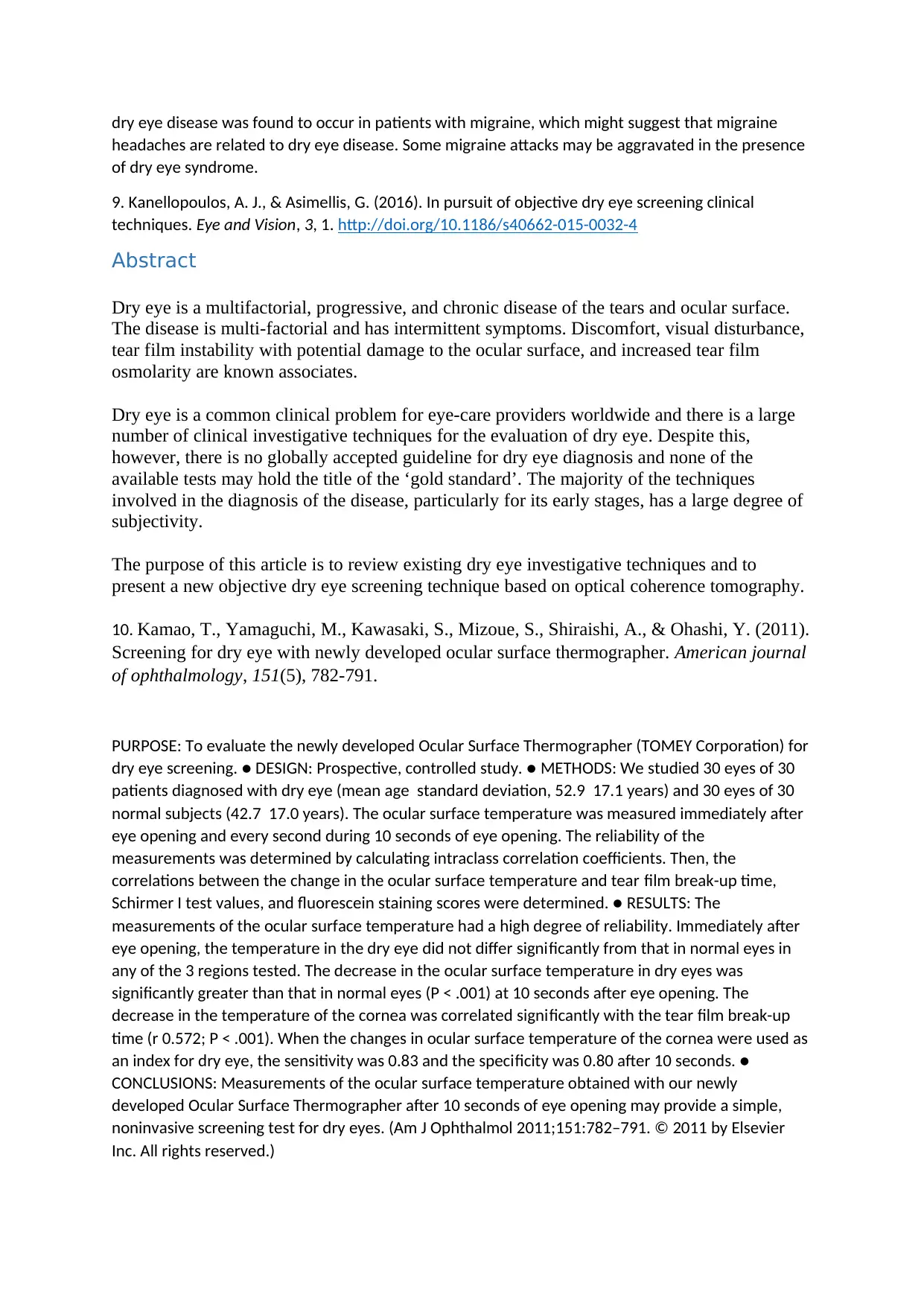
dry eye disease was found to occur in patients with migraine, which might suggest that migraine
headaches are related to dry eye disease. Some migraine attacks may be aggravated in the presence
of dry eye syndrome.
9. Kanellopoulos, A. J., & Asimellis, G. (2016). In pursuit of objective dry eye screening clinical
techniques. Eye and Vision, 3, 1. http://doi.org/10.1186/s40662-015-0032-4
Abstract
Dry eye is a multifactorial, progressive, and chronic disease of the tears and ocular surface.
The disease is multi-factorial and has intermittent symptoms. Discomfort, visual disturbance,
tear film instability with potential damage to the ocular surface, and increased tear film
osmolarity are known associates.
Dry eye is a common clinical problem for eye-care providers worldwide and there is a large
number of clinical investigative techniques for the evaluation of dry eye. Despite this,
however, there is no globally accepted guideline for dry eye diagnosis and none of the
available tests may hold the title of the ‘gold standard’. The majority of the techniques
involved in the diagnosis of the disease, particularly for its early stages, has a large degree of
subjectivity.
The purpose of this article is to review existing dry eye investigative techniques and to
present a new objective dry eye screening technique based on optical coherence tomography.
10. Kamao, T., Yamaguchi, M., Kawasaki, S., Mizoue, S., Shiraishi, A., & Ohashi, Y. (2011).
Screening for dry eye with newly developed ocular surface thermographer. American journal
of ophthalmology, 151(5), 782-791.
PURPOSE: To evaluate the newly developed Ocular Surface Thermographer (TOMEY Corporation) for
dry eye screening. ● DESIGN: Prospective, controlled study. ● METHODS: We studied 30 eyes of 30
patients diagnosed with dry eye (mean age standard deviation, 52.9 17.1 years) and 30 eyes of 30
normal subjects (42.7 17.0 years). The ocular surface temperature was measured immediately after
eye opening and every second during 10 seconds of eye opening. The reliability of the
measurements was determined by calculating intraclass correlation coefficients. Then, the
correlations between the change in the ocular surface temperature and tear film break-up time,
Schirmer I test values, and fluorescein staining scores were determined. ● RESULTS: The
measurements of the ocular surface temperature had a high degree of reliability. Immediately after
eye opening, the temperature in the dry eye did not differ significantly from that in normal eyes in
any of the 3 regions tested. The decrease in the ocular surface temperature in dry eyes was
significantly greater than that in normal eyes (P < .001) at 10 seconds after eye opening. The
decrease in the temperature of the cornea was correlated significantly with the tear film break-up
time (r 0.572; P < .001). When the changes in ocular surface temperature of the cornea were used as
an index for dry eye, the sensitivity was 0.83 and the specificity was 0.80 after 10 seconds. ●
CONCLUSIONS: Measurements of the ocular surface temperature obtained with our newly
developed Ocular Surface Thermographer after 10 seconds of eye opening may provide a simple,
noninvasive screening test for dry eyes. (Am J Ophthalmol 2011;151:782–791. © 2011 by Elsevier
Inc. All rights reserved.)
headaches are related to dry eye disease. Some migraine attacks may be aggravated in the presence
of dry eye syndrome.
9. Kanellopoulos, A. J., & Asimellis, G. (2016). In pursuit of objective dry eye screening clinical
techniques. Eye and Vision, 3, 1. http://doi.org/10.1186/s40662-015-0032-4
Abstract
Dry eye is a multifactorial, progressive, and chronic disease of the tears and ocular surface.
The disease is multi-factorial and has intermittent symptoms. Discomfort, visual disturbance,
tear film instability with potential damage to the ocular surface, and increased tear film
osmolarity are known associates.
Dry eye is a common clinical problem for eye-care providers worldwide and there is a large
number of clinical investigative techniques for the evaluation of dry eye. Despite this,
however, there is no globally accepted guideline for dry eye diagnosis and none of the
available tests may hold the title of the ‘gold standard’. The majority of the techniques
involved in the diagnosis of the disease, particularly for its early stages, has a large degree of
subjectivity.
The purpose of this article is to review existing dry eye investigative techniques and to
present a new objective dry eye screening technique based on optical coherence tomography.
10. Kamao, T., Yamaguchi, M., Kawasaki, S., Mizoue, S., Shiraishi, A., & Ohashi, Y. (2011).
Screening for dry eye with newly developed ocular surface thermographer. American journal
of ophthalmology, 151(5), 782-791.
PURPOSE: To evaluate the newly developed Ocular Surface Thermographer (TOMEY Corporation) for
dry eye screening. ● DESIGN: Prospective, controlled study. ● METHODS: We studied 30 eyes of 30
patients diagnosed with dry eye (mean age standard deviation, 52.9 17.1 years) and 30 eyes of 30
normal subjects (42.7 17.0 years). The ocular surface temperature was measured immediately after
eye opening and every second during 10 seconds of eye opening. The reliability of the
measurements was determined by calculating intraclass correlation coefficients. Then, the
correlations between the change in the ocular surface temperature and tear film break-up time,
Schirmer I test values, and fluorescein staining scores were determined. ● RESULTS: The
measurements of the ocular surface temperature had a high degree of reliability. Immediately after
eye opening, the temperature in the dry eye did not differ significantly from that in normal eyes in
any of the 3 regions tested. The decrease in the ocular surface temperature in dry eyes was
significantly greater than that in normal eyes (P < .001) at 10 seconds after eye opening. The
decrease in the temperature of the cornea was correlated significantly with the tear film break-up
time (r 0.572; P < .001). When the changes in ocular surface temperature of the cornea were used as
an index for dry eye, the sensitivity was 0.83 and the specificity was 0.80 after 10 seconds. ●
CONCLUSIONS: Measurements of the ocular surface temperature obtained with our newly
developed Ocular Surface Thermographer after 10 seconds of eye opening may provide a simple,
noninvasive screening test for dry eyes. (Am J Ophthalmol 2011;151:782–791. © 2011 by Elsevier
Inc. All rights reserved.)
⊘ This is a preview!⊘
Do you want full access?
Subscribe today to unlock all pages.

Trusted by 1+ million students worldwide
1 out of 6
Your All-in-One AI-Powered Toolkit for Academic Success.
+13062052269
info@desklib.com
Available 24*7 on WhatsApp / Email
![[object Object]](/_next/static/media/star-bottom.7253800d.svg)
Unlock your academic potential
Copyright © 2020–2025 A2Z Services. All Rights Reserved. Developed and managed by ZUCOL.

